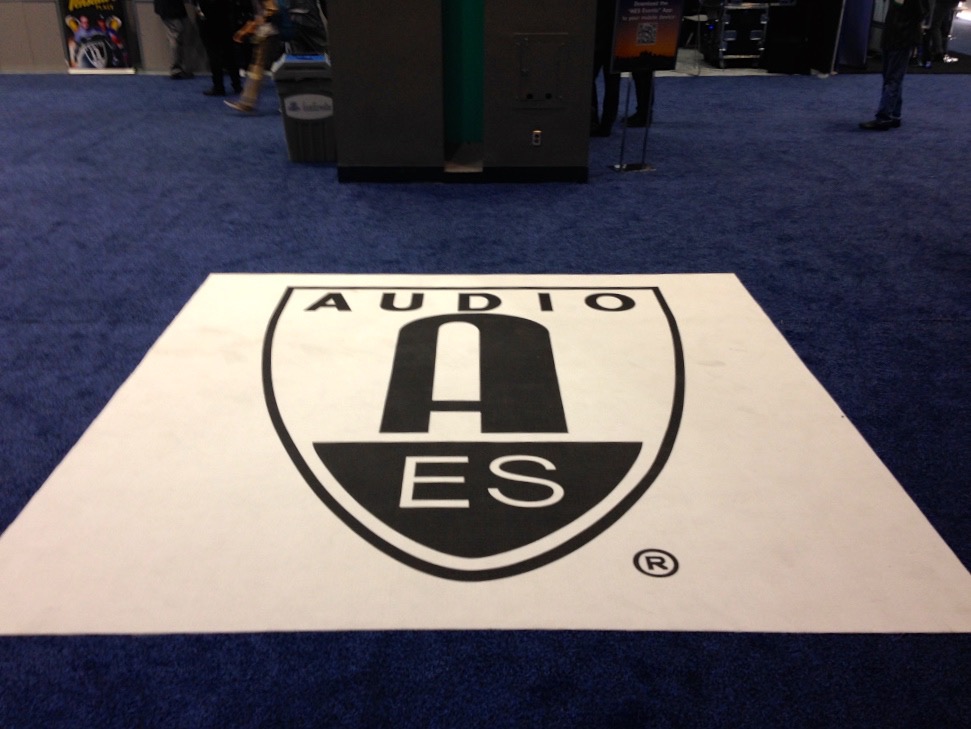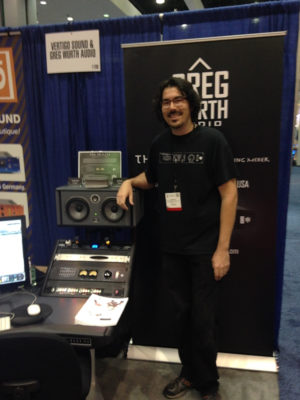Op-Ed: Truth, Rumors and Real Life at the 141st AES Convention in Los Angeles
The 141st AES convention AKA AES Los Angeles 2016 is officially a wrap. What did we learn from this year’s annual Gathering of the Gearheads?
If ye seek technological evolution, it was there on display. Hardware manufacturers and software developers continue to move steadily forward, with new additions or updated models that sound better, improve workflows or reduce CPU load. There were some fresh new faces in the aisles, and long-established companies that are clearly still having fun with their products.
The growing importance of Dante to manufacturers of consoles and interfaces was also clear to see. An uncompressed, multi-channel digital media networking technology, with near-zero latency and synchronization, it’s emerged as a big problem solver in major studios and project facilities alike – everyone that can adopt Dante is incorporating it into their offerings ASAP.
Solutions for virtual reality (VR) mixing and post were even easier to see. Just watch out for anyone with a headset on, gazing in all directions and seeming pretty geeked about it.
Population Density
The 141st marked the AES’ second run in its return to LA, and hopes were high that it would mark getting into a Southern California groove, with increased energy and attendance around this year’s show.
But it was not to be. Doubtless, the organization will release robust numbers about registration and visitors to the show—and as noted by SonicScoop, a strong program of workshops, papers, and events was indeed assembled—but none of that translated into strong foot traffic during three days of exhibits.
The show floor of the 141st wasn’t a ghost town, and it hadn’t shrank to dangerously small proportions as has been observed in years past. But the intangible buzz that elevates a tradeshow like AES wasn’t there. Exhibitors who were hoping for a strong weekend ran out of tomorrows on Saturday, when attendance felt relatively light on the final day.
Speculation on the show’s future was a common conversational thread among exhibitors and visitors, fueled by an announcement that NAB Show New York and the AES will be co-locating their 2017 conventions at NYC’s Jacob Javits Center (October 18-21). While the pairing of audio and video shows makes sense on paper, it naturally raises questions to an already jittery constituency unsure about the long-term viability of their flagship convention.
From there, the gossip escalated even further: Rumors were circulating throughout the show that the AES convention was done in LA, never to return after the 141st. According to a spokesman for the AES, the rumors are unfounded and the alternating NYC-LA scheduling is to remain in place.
We should all hope that is truly the case: A bicoastal show is essential for the show’s relevance, providing easy and affordable access for a significant percentage of audio’s working professionals, facilities and manufacturers/developers who call Southern California home. Still, the fact that these rumors even had credibility points to a problematic deficit of confidence in today’s AES. People need to be shaking hands on the show floor, not shaking heads.
Newbie Knowledge
One important aspect of AES is that the script gets flipped. In an industry where producers, engineers and mixers are the star talent – along with their platinum clients, of course – the three days of AES exhibitions provide time for the brains behind their gear, DAWs, and plug-ins to take the spotlight.
In a show floor jammed with jaded exhibitors whose main goal is simply to survive the convention, fresh perspective is necessary to gauge the show’s relevance. One such viewpoint was available from Greg Wurth, a rookie AES exhibitor displaying The Oracle, a 16-channel all discrete summing mixer designed “without compromise” and hand-built by Steve Firlotte of Inward Connections/Tree Audio fame.
The main engineer at the studio of guitar legend Steve Vai, Wurth is just 32 and helming an audio concern that’s less than a year old. “I didn’t launch my own brand because I necessarily wanted to start a company,” Wurth says. “It came out of necessity. If something essential doesn’t exist I say, ‘Why doesn’t somebody build it?’”
Wurth was displaying the $4395 Oracle, partnered with Vertigo Sound in Booth #1106. “I decided it was time to have a booth, show it, and let people come check it out in person,” explains Wurth, who already enjoys a large social media following thanks to his straightforward style of sharing audio knowledge. “AES was absolutely helpful venue to debut the Oracle. People like Jack Douglas and Eddie Kramer came by, and they gave me a lot of respect. A lot of other manufacturers visited and gave me a warm welcome. It was great, it just felt natural.”
For Wurth, being in exhibitor for the first time instead of having the freedom to walk the aisles, required some adjusting. “It was a little stressful at times,” he admits. “I love talking about gear, but I had no idea what it would be like to repeat myself 5 million times to people about the same thing. And I didn’t get to walk around, so if some of my friends didn’t come see me, I didn’t get to see them. It was definitely a positive experience, although I would do things a lot differently the next time around.
“I partnered with Vertigo Sound because I respect their company, and I thought our gear would complement each other and be a good look, which it was. But down the line, The Oracle is such a unique product that I just need to have my own booth and make it the centerpiece. That’s a part of the learning process.”
According to Wurth, the AES was helpful far ahead of the show, beyond just cashing a check and assisting with logistics upon load-in. “We reserved the booth pretty early on, and I was very outspoken to the AES – I wanted them to get me into a good booth,” he says. “I was bugging them from early on, they got what I was doing, and they help me get the booth I was looking for, so I could be around brands that I thought would get me a lot of exposure. Overall, it was very welcoming: I didn’t feel like I was thrown into a shark tank.”
For Wurth and his wife/marketing director Lisamarie Costabile, crossing the country for the 2017 AES in NYC will be a serious consideration. “I’m a new company, I don’t have any employees, and I have a five-year-old daughter that I want to spend as much time with as possible,” says Wurth. “It’s definitely easier for me to exhibit in the city that I live in.”
Necessary Evolutions
AES was the obvious place to launch The Oracle, despite the doubts currently surrounding the show. “AES stands for ‘Audio Engineering Society,’” Wurth points out. “Those are the people that should know first-hand what my product is about. I know that people are saying that AES is shrinking and shrinking, but I’d like to think that maybe it’s going to grow, because gear sales are changing. A lot of companies are making affordable equipment, so people are getting into analog gear again. The 500-series fad is putting things into people’s hands very easily. Hopefully the show is going to grow.”
If the AES doesn’t reverse the trend—real or perceived—of declines in membership and attendance, however, Wurth sees questions on the horizon for fledgling exhibitors like himself. “There is a concern,” he acknowledges. “Because if people don’t come to these conventions, then it doesn’t give someone like me incentive to pay for a booth – that’s a lot of money to invest with no guarantee of anything. So I hope the community can come together and understand that it’s important.
“I think this year’s show could’ve been much more crowded. Since they were giving away so many free passes, it makes me think that the AES is struggling to get people to go. There’s a new generation, and I know that social media is how you reach the audience – I don’t know if the AES is grasping that. When you get onto their Website, it’s not clear how to get a pass. I’ve had to hold people’s hands to let them know how to get a badge and find my booth. I’m always trying to better myself and learn how to do things better the next time. I’d like to think that they [the AES] do that too: if they think that the show is shrinking, then something’s got to change.”
Despite the challenges that the AES convention faces, Wurth feels that his three days exhibiting at AES – plus two more hard days setting up and breaking down – was time well spent for him and his new venture. “The best part was meeting new people, seeing everyone that I’ve been talking to online, and feeling the support. I got so much support and mutual respect. I was with my wife and family and friends – that was a dream come true.”
Ultimately, it’s that human contact that continues to make trade shows like AES matter, even in a time where all the info you need is online. “Exhibiting live at a show means you’re walking the walk,” says Wurth. “You can have a certain persona online, but in reality can you prove that you’re that same person? That you’re delivering that same quality of attention and generosity in real life? I think it’s important to meet people and see what they’re all about. You want to believe the person behind the product.”
- David Weiss
Please note: When you buy products through links on this page, we may earn an affiliate commission.










Danwriter
October 6, 2016 at 3:22 pm (9 years ago)DTLA’s miserable hotel situation — $500 a night at the Ace or $150 to share a room with a rat at the Stillwell — makes the location nearly untenable for many non-locals. What saves it is the fact that half of the many new condos opening in DTLA’s high-rises are operated solely as Air BnBs and VRBOs. I wonder what that market’s going to look like in two years?